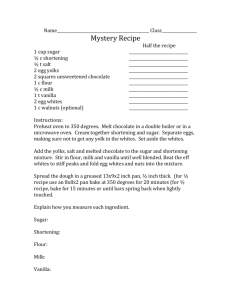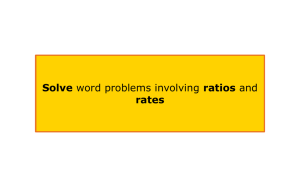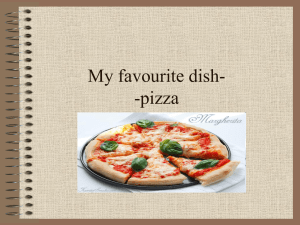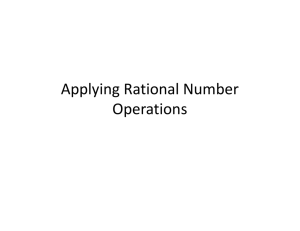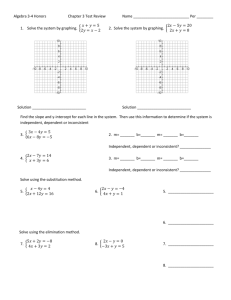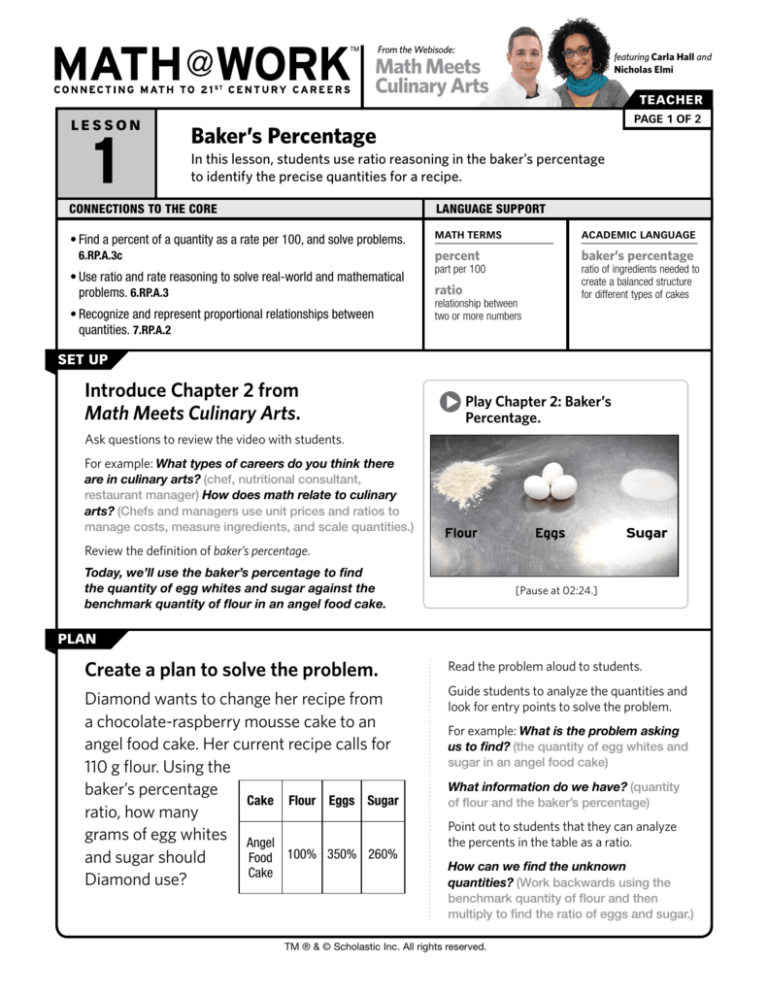
From the Webisode:
featuring Carla Hall and
Nicholas Elmi
Math Meets
Culinary Arts
lesson
1
teacher
page 1 of 2
Baker’s Percentage
In this lesson, students use ratio reasoning in the baker’s percentage
to identify the precise quantities for a recipe.
Connections to the Core
language support
•Find a percent of a quantity as a rate per 100, and solve problems.
math terms
academic language
percent
baker’s percentage
6.RP.A.3c
•Use ratio and rate reasoning to solve real-world and mathematical
problems. 6.RP.A.3
•Recognize and represent proportional relationships between
quantities. 7.RP.A.2
part per 100
ratio
relationship between
two or more numbers
ratio of ingredients needed to
create a balanced structure
for different types of cakes
set up
Introduce Chapter 2 from
Math Meets Culinary Arts.
Play Chapter 2: Baker’s
Percentage.
Ask questions to review the video with students.
For example: What types of careers do you think there
are in culinary arts? (chef, nutritional consultant,
restaurant manager) How does math relate to culinary
arts? (Chefs and managers use unit prices and ratios to
manage costs, measure ingredients, and scale quantities.)
Review the definition of baker’s percentage.
Today, we’ll use the baker’s percentage to find
the quantity of egg whites and sugar against the
benchmark quantity of flour in an angel food cake.
[Pause at 02:24.]
PLAN
Create a plan to solve the problem.
Diamond wants to change her recipe from
a chocolate-raspberry mousse cake to an
angel food cake. Her current recipe calls for
110 g flour. Using the
baker’s percentage
Cake Flour Eggs Sugar
ratio, how many
grams of egg whites Angel
Food 100% 350% 260%
and sugar should
Cake
Diamond use?
Read the problem aloud to students.
Guide students to analyze the quantities and
look for entry points to solve the problem.
For example: What is the problem asking
us to find? (the quantity of egg whites and
sugar in an angel food cake)
What information do we have? (quantity
of flour and the baker’s percentage)
Point out to students that they can analyze
the percents in the table as a ratio.
How can we find the unknown
quantities? (Work backwards using the
benchmark quantity of flour and then
multiply to find the ratio of eggs and sugar.)
TM ® & © Scholastic Inc. All rights reserved.
From the Webisode:
featuring Carla Hall and
Nicholas Elmi
Math Meets
Culinary Arts
lesson
1
teacher
page 2 of 2
Baker’s Percentage, continued
standards for
mathematical
practice
Make Use of Structure
Students use the structure of the ratio in the
baker’s percentage to find the unknown quantities.
Model With Mathematics
Students represent quantities as a ratio and apply
proportional reasoning to create a solution.
solve
Have student pairs solve the problem as you circulate.
Encourage students to come up with multiple strategies and represent the problem
situation in different ways. Guide students to work backwards to check their work.
s up p o r t
e xte nd
Ask questions based on common errors to support
student understanding.
■■
■■
■■
How many times more egg whites do you
need than flour? How do you know?
Can you draw a model to represent the
quantities of flour, eggs, and sugar?
Ask questions to encourage students to extend
their thinking.
■■
■■
Which ingredient is there the most of?
The least? How do you know?
Quantities based on the baker’s percentage
can vary up to 20%. What is the minimum
quantity of sugar in this recipe?
How many grams of egg whites and sugar
would you need to bake an angel food cake
with 55 g flour?
share
Have students present their solutions.
homework
i de as
Ask students from each pair to explain their solutions to the class. Show
at least two different approaches to solving the problem and one incorrect
solution. To extend classroom discussion, call on students to explain the
reasoning of the student who is presenting.
Have students
apply the
baker’s
percentage!
Possible student work:
Students choose
a cake recipe and
determine if it
matches the baker’s
percentage.
Flour 100%: 110 g
100 + 10 = 110
100(1) + 100(0.1) = 110
100 × 1.1 = 110 g
So, the scale factor is 1.1.
Eggs 350%: ?
350 × 1.1 = 350(1) + 350(0.1)
= 350 + 35
= 385 g
Sugar 260%: ?
260 × 1.1 = 260(1) + 260(0.1)
= 260 + 26
= 286 g
■■
Therefore, 100%: 350%: 260% = 110 g: 385 g: 286 g.
■■
Play the Chapter 2 Solution from Math Meets Culinary Arts.
Have students complete the Practice and Reflect sections on Student Page 2.
TM ® & © Scholastic Inc. All rights reserved.
■■
What is
the baker’s
percentage for
this type of cake?
How many grams
of eggs and sugar
should you use?
Is your answer
reasonable?
Your Name student
lesson
1
Baker’s Percentage
math terms
percent
part per 100
ratio
page 1 of 2
relationship between
two or more numbers
Diamond wants to change her recipe from
a chocolate-raspberry mousse cake to an
angel food cake. Her current recipe calls for
110 g flour. Using the baker’s percentage ratio,
how many grams of egg whites and sugar
should Diamond use?
plan
Create a plan to solve the problem with your partner.
solve
Use your plan to solve the problem.
TM ® & © Scholastic Inc. All rights reserved.
Cake
Flour Eggs Sugar
Angel
Food 100% 350% 260%
Cake
Your Name student
lesson
1
practice
page 2 of 2
Baker’s Percentage, continued
Apply your skills to solve another problem.
Diamond bakes a sponge cake with 50 g flour, 112.5 g egg whites,
and 77.5 g sugar. Based on the ratio in this recipe, what is the
baker’s percentage for a sponge cake?
reflect
Explain how you made sense of the math.
How did you find the unknown quantities?
Why are percents a type of ratio?
I found the unknown quantities by Percents are a type of ratio because SCORE
TM ® & © Scholastic Inc. All rights reserved.
Your Name student
lesson
1
Baker’s Percentage
math terms
percent
part per 100
ratio
relationship between
two or more numbers
plan
page 1 of 2
POSSIBLE STUDENT WORK
Diamond wants to change her recipe from
a chocolate-raspberry mousse cake to an
angel food cake. Her current recipe calls for
110 g flour. Using the baker’s percentage ratio,
how many grams of egg whites and sugar
should Diamond use?
Cake
Flour Eggs Sugar
Angel
Food 100% 350% 260%
Cake
Create a plan to solve the problem with your partner.
The baker’s percentage ratio is 100% flour: 350% eggs: 260% sugar.
First, I will draw models to represent the three quantities.
Then, I will rewrite the percents as decimals and multiply to find the
unknown quantities.
solve
Use your plan to solve the problem.
100%
flour
(110 g)
350%
eggs
350% of 110 g
3.5 × 110 g = 385 g
260% of 110 g
2.6 × 110 g = 286 g
260%
sugar
The ratio is 110 g flour: 385 g eggs: 286 g sugar.
Diamond should use 385 g egg whites and 286 g sugar.
TM ® & © Scholastic Inc. All rights reserved.
Your Name student
lesson
1
practice
Baker’s Percentage, continued
page 2 of 2
POSSIBLE STUDENT WORK
Apply your skills to solve another problem.
Diamond bakes a sponge cake with 50 g flour, 112.5 g egg whites,
and 77.5 g sugar. Based on the ratio in this recipe, what is the
baker’s percentage for a sponge cake?
The ratio in this recipe is 50 g flour: 112.5 g eggs: 77.5 g sugar.
To find the baker’s percentage, I need to measure the quantities of eggs and sugar
against the benchmark of 100% flour.
Then, I can find the scale factor and multiply to find the unknown
baker’s percentage.
To represent 50 g flour as a benchmark of 100%, I will double the quantity
to get 100 g. I will use 2 as the scale factor.
Flour 50 × 2 = 100%
Eggs 112.5 × 2 = 225%
Sugar 77.5 × 2 = 155%
Sponge Cake
Recipe
Baker’s Percentage
Flour
50 g
100%
Eggs
112.5 g
225%
Sugar
77.5 g
155%
The baker’s percentage for a sponge cake is 100% flour: 225% eggs: 155% sugar.
reflect
Explain how you made sense of the math.
How did you find the unknown quantities?
I found the unknown quantities by representing
Why are percents a type of ratio?
Percents are a type of ratio because a percent compares two or more quantities
the quantities as a ratio against the
benchmark of 100% flour.
by representing them as parts per 100.
SCORE
TM ® & © Scholastic Inc. All rights reserved.



